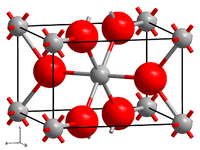Germanium (IV) oxide
| Crystal structure | ||||||||||||||||
|---|---|---|---|---|---|---|---|---|---|---|---|---|---|---|---|---|

|
||||||||||||||||
| __ Ge 4+ __ O 2− | ||||||||||||||||
| General | ||||||||||||||||
| Surname | Germanium (IV) oxide | |||||||||||||||
| other names |
Germanium dioxide |
|||||||||||||||
| Ratio formula | GeO 2 | |||||||||||||||
| Brief description |
white odorless solid |
|||||||||||||||
| External identifiers / databases | ||||||||||||||||
|
||||||||||||||||
| properties | ||||||||||||||||
| Molar mass | 104.59 g mol −1 | |||||||||||||||
| Physical state |
firmly |
|||||||||||||||
| density |
4.23 g cm −3 |
|||||||||||||||
| Melting point |
1086-1115 ° C |
|||||||||||||||
| solubility |
poor in water (4.5 g l −1 at 25 ° C) |
|||||||||||||||
| Refractive index |
1.7 |
|||||||||||||||
| safety instructions | ||||||||||||||||
|
||||||||||||||||
| Toxicological data | ||||||||||||||||
| As far as possible and customary, SI units are used. Unless otherwise noted, the data given apply to standard conditions . Refractive index: Na-D line , 20 ° C | ||||||||||||||||
Germanium (IV) oxide is a chemical compound from the group of germanium compounds and oxides .
Occurrence
Germanium (IV) oxide occurs naturally in the form of the mineral argutite .
Extraction and presentation
Germanium (IV) oxide is formed when germanium or germanium disulphide is strongly annealed in an oxygen atmosphere.
The hydrolysis of germanium (IV) chloride is also very simple . In contrast to silicon, which initially forms silicic acids during the hydrolysis of silicon tetrachloride , germanium does not produce stable hydroxides , but hydrate-free germanium dioxide.
properties
Germanium (IV) oxide occurs in several crystal structures parallel to those of silicon dioxide . Hexagonal GeO 2 (melting point 1115 ° C, density 4.7 g / cm³) has the same structure as α- quartz and is formed during the hydrolysis of germanium chloride and the decomposition of germanates. The tetragonal GeO 2 (as mineral argutite, melting point 1086 ° C, density 6.239 g / cm³) has a rutile- like structure (like stishovite ) and is created by heating germanium (IV) oxide with water under pressure and at higher temperatures or for several hours when evaporating an aqueous germanium (IV) oxide solution with a little ammonium fluoride . The amorphous GeO 2 corresponds to quartz glass (density 3.637 g / cm³) and is always created when a melt of germanium (IV) oxide cools. The rutile modification can be converted into the soluble quartz-analogous form at 1033 ° C. In contrast to the others, this modification is somewhat soluble in water, whereby the solution reacts clearly acidic (formation of germanic acid ). In acids, germanium (IV) oxide dissolves only with difficulty ( easily in strong hydrochloric acid ), but easily in alkalis (e.g. alkali lye ), whereby germanates are formed.
use
Germanium (IV) oxide is used in the production of optical glasses that are transparent in the infrared. In polyester chemistry, it is used as a catalyst in the production of certain non-yellowing polyester fibers and granulates, especially for recyclable PET bottles. It also serves as the starting material for the production of germanates such as hafnium germanate HfGeO 4 .
Individual evidence
- ↑ a b c d Entry for CAS no. 1310-53-8 in the GESTIS substance database of the IFA , accessed on June 19, 2010(JavaScript required) .
- ↑ Germanium (IV) oxide data sheet (PDF) from Merck , accessed on January 19, 2011.
- ↑ a b Germanium Oxide Powder (Reade) ( Memento of the original from November 29, 2010 in the Internet Archive ) Info: The archive link has been inserted automatically and has not yet been checked. Please check the original and archive link according to the instructions and then remove this notice.
- ↑ a b c Germanium (IV) oxide data sheet from Sigma-Aldrich , accessed on April 3, 2011 ( PDF ).
- ↑ a b c Georg Brauer (ed.), With the collaboration of Marianne Baudler a . a .: Handbook of Preparative Inorganic Chemistry. 3rd, revised edition. Volume II, Ferdinand Enke, Stuttgart 1978, ISBN 3-432-87813-3 .
- ^ Robert Schwarz: Contributions to the chemistry of germanium. (I. Communication) . In: Reports of the German Chemical Society (A and B Series) . tape 62 , no. 9 , October 9, 1929, p. 2477 , doi : 10.1002 / cber.19290620902 .
- ^ Robert Schwarz, PW Schenk, H. Giese: Contributions to the chemistry of Germanium (VI.) . In: Reports of the German Chemical Society (A and B Series) . tape 64 , no. 2 , February 4, 1931, p. 362 , doi : 10.1002 / cber.19310640227 .
- ↑ Greenwood, Norman N .; Earnshaw, A. (1997), Chemistry of the Elements (2nd ed.), Oxford: Butterworth-Heinemann, ISBN 0-08-037941-9 .
- ^ AF Holleman , E. Wiberg , N. Wiberg : Textbook of Inorganic Chemistry . 102nd edition. Walter de Gruyter, Berlin 2007, ISBN 978-3-11-017770-1 , p. 1019.
- ↑ Page no longer available , search in web archives: Raw materials for future technologies. ( Page no longer available , search in web archives ) Info: The link was automatically marked as defective. Please check the link according to the instructions and then remove this notice. Fraunhofer Institute for Systems and Innovation Research ISI.


